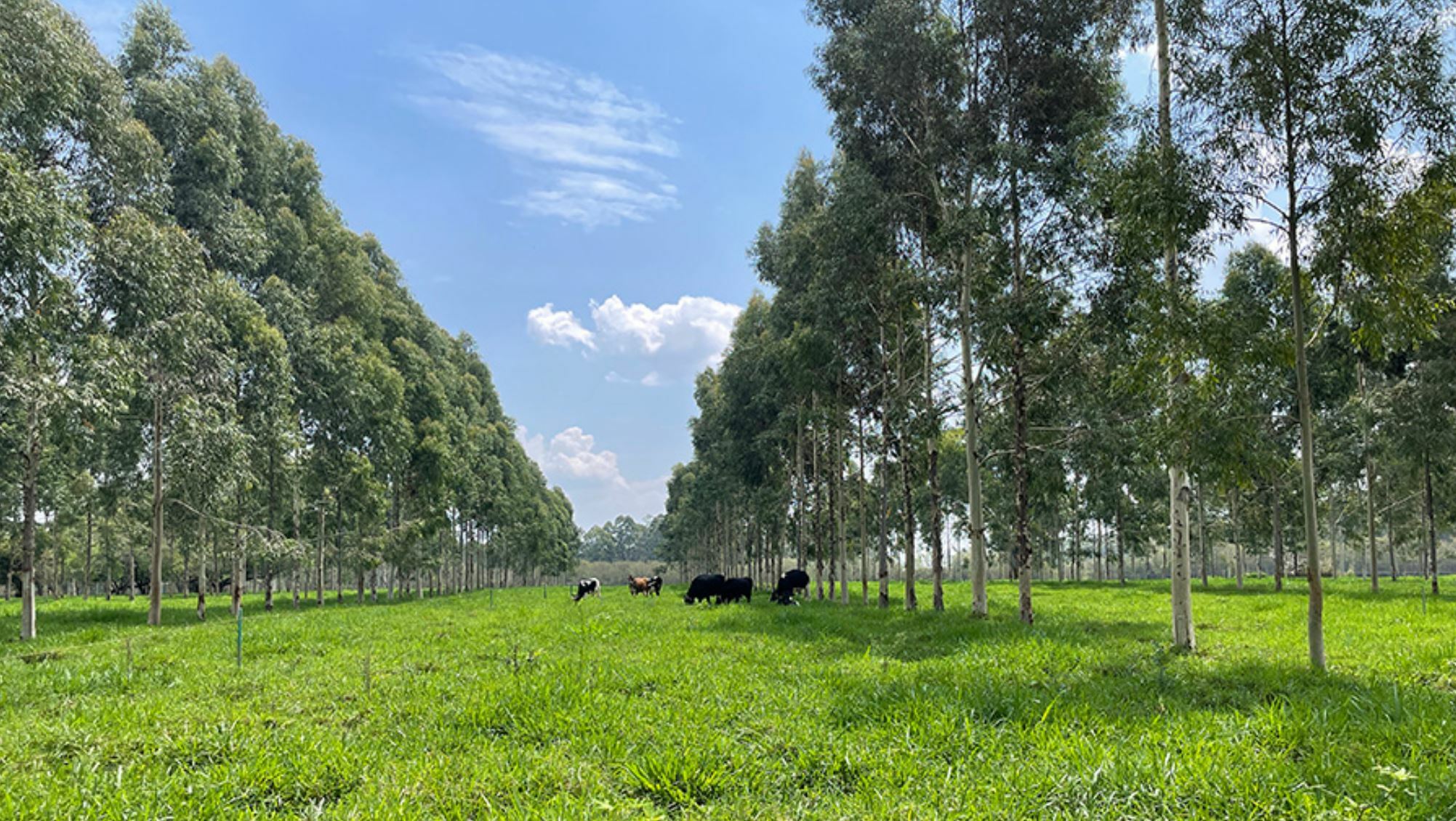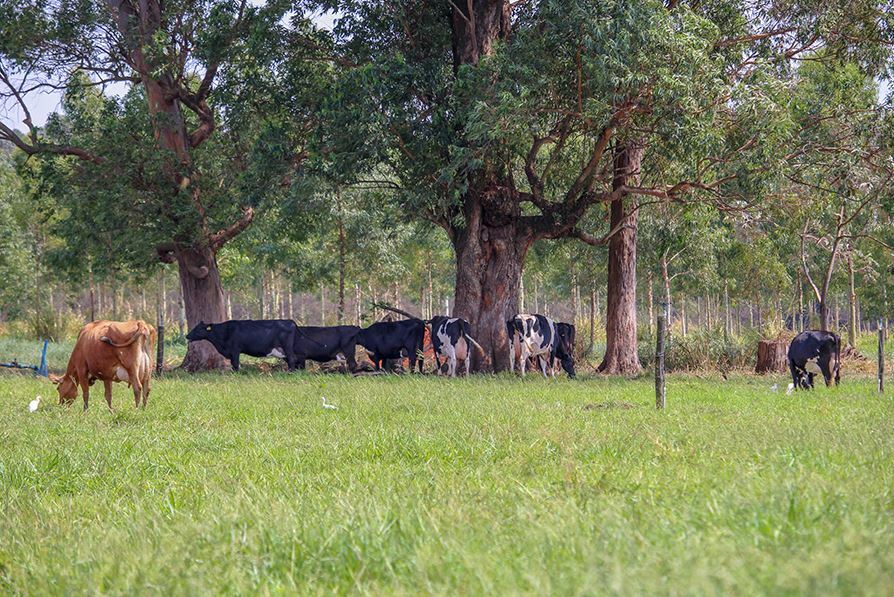



Study: dairy farming in Brazil generates low carbon emissions in tree systems
- A study by Embrapa shows that the carbon footprint (a measure that calculates the carbon emission into the atmosphere by pasture-raising dairy farming) is low.
- He also points out that, in intensive grazing systems, 52 trees per cow are needed to reach zero carbon milk.
- The study considered two types of production systems - intensive and extensive - and the two breeds most used in dairy farming.
- Tree planting is a very important greenhouse gas (GHG) mitigation strategy for decarbonizing agriculture.
- The work also proved the land-saving effect (optimization of land use by the sector).
- The reduction of emissions and the environmental footprint are differentials of Brazilian livestock, which are mainly carried out on pastures.
A study conducted by Embrapa Pecuária Sudeste (SP) shows that 52 trees per cow are needed in intensive production systems to reach zero carbon milk. Tree planting is a strategy to offset the emission of greenhouse gases (GHGs) and can be used by ranchers to develop more sustainable livestock farming aimed at decarbonization. In extensive systems (low technological level), this amount is 33 eucalyptus trees.
The work, published in the international publication Frontiers in Veterinary Science , evaluated the effect of Holstein cows (HPB – Black and White) and Jersolandas at different levels of intensification - continuous grazing with low stocking rate and irrigated rotation with high stocking rate - and the interaction between these two factors in GHG mitigation.
In the experiment, the carbon balance between GHG emissions (including methane - enteric CH4) and GHG removals was carried out, through soil carbon sequestration. These variables were used to calculate the number of trees needed to mitigate the emission and the land saving effect.
Two different Brazilian pasture production models were considered – extensive and intensive. The work also compared two breeds, HPB and Jersolanda, traditionally used in the country for milk production.
Considering only the race, in the comparison between Dutch and Jersolandas, these are more efficient in terms of emissions. With the planting of 38 trees per cow, the producer compensates; those using the Holstein breed need eight more trees per cow.
According to researcher Patrícia PA Oliveira , Brazilian livestock is mainly carried out on pastures. In this way, the demand to reduce emissions and the environmental footprint gives the country an additional advantage. As cattle are raised on pasture, the need for trees to offset GHG emissions is lower, because in accounting for the carbon balance, soil carbon sequestration, positive in the two tested systems, contributes to offsetting emissions.
Land-saving effect

Another benefit identified in the survey was the land-saving effect (technologies adopted by the productive sector that allow sustainable increases in total production in the same area, avoiding the opening of new areas for agricultural production). “The adoption of suitable breeds and the intensification of livestock production systems on pasture are alternatives to optimize the use of land by the sector”, he points out. Proof of this is the result obtained by Embrapa. The scientist reveals that the data showed that the intensification of pastures contributes to raising milk production and saving 2.64 hectares of land.
The stocking rate in this model was around seven cows per hectare, while in the extensive one, only two cows per hectare. “This means that it is possible to produce the same amount of milk in one hectare of the intensive system as in 3.64 hectares of the extensive system. The adopted intensification makes it possible to reduce the pressure for deforestation of the remaining 2.64 ha. Within this area, it is possible to preserve approximately 145 different native tree species, in addition to maintaining several species of Atlantic Forest fauna”, explains Patrícia.
The trees needed to mitigate emissions were calculated considering the carbon balance within the farm gate. The annual growth rate and gas accumulation in eucalyptus trunks were obtained in silvopastoral systems close to the experiment site.
The results were also promising with regard to the carbon footprint per liter of milk (corrected for fat and protein contents), with values below 0.5 kg of CO 2 per liter of milk for all evaluated treatments.
Brazilian milk production and sustainability issues
Brazil produces 35 billion liters of milk per year, ranking third in the world. The properties, mostly small and medium-sized, are distributed in 98% of Brazilian municipalities, according to data from the Brazilian Institute of Geography and Statistics ( IBGE). In total, more than four million people are involved in milk production in the country. However, productivity is very low on most of these farms. The average liter of milk per lactating cow is around four liters a day in Brazil, while the world average is close to 10 liters a day. “This disparate scenario of low systematic efficiency can be explained by the production model adopted. Grasses are the main source of food for dairy cattle in systems based on poor quality pastures, which are often managed below their potential stocking rate, with a national average of one cow per hectare”, adds the researcher.
The sector, in addition to having a demand to increase productivity, has seen an increase in consumer expectations in recent years in relation to product quality and issues of sustainability and animal welfare.
There is growing concern about climate change. In Brazil, agriculture is responsible for 33.6% of Brazilian GHG emissions, 19% of which come from enteric fermentation. The bovine herd contributes with 97% of the methane emissions, being 86% of the beef herd and 11% of the dairy cattle.
“Strategies to reduce greenhouse gas emissions, such as changes in the management of milk production systems on pasture, through the intensification of forage use and the use of more specialized animal breeds and crossbreeding, can contribute to offsetting emissions. of GHG. Compared to traditional dairy systems they are carbon sinks. These actions - improving soil fertility and pasture management, nutrition and animal genetics are basic points that are easy to adopt - can contribute to the carbon balance of dairy farms and reduce the need for other external procedures, such as the purchase of carbon credits to offset emissions”, emphasizes the researcher.
The sustainable intensification of dairy farming systems could become a key technology for mitigating climate change. “Results from long-term experiments in this area are important for tropical and subtropical regions and need to be carried out, even though they are quite costly and laborious”, he adds.
The study design

The research was conducted at the Canchim farm, headquarters of Embrapa Pecuária Sudeste, in São Carlos (SP), for two years.
The experiment used two grazing management systems: extensive - continuous grazing system with low stocking rate and intensive - irrigated rotational grazing system with high stocking rate. The native forest (Atlantic Forest) was used as a reference area for the calculation of carbon stocks. Each treatment had two area replications.
24 cows were used in each evaluation period, totaling 48 cows throughout the experiment. All, within each group of genotypes (Holstein and Jersolanda), uniform in age, live weight, lactation stage and milk production, with approximately 90 days of lactation at the beginning of each experimental period.
The research project had financial support from Embrapa, the National Council for Scientific and Technological Development (CNPq), the São Paulo Research Foundation (FAPESP) and the Coordination for the Improvement of Higher Education Personnel (Capes).
All images courtesy of Gisele Rosso.


